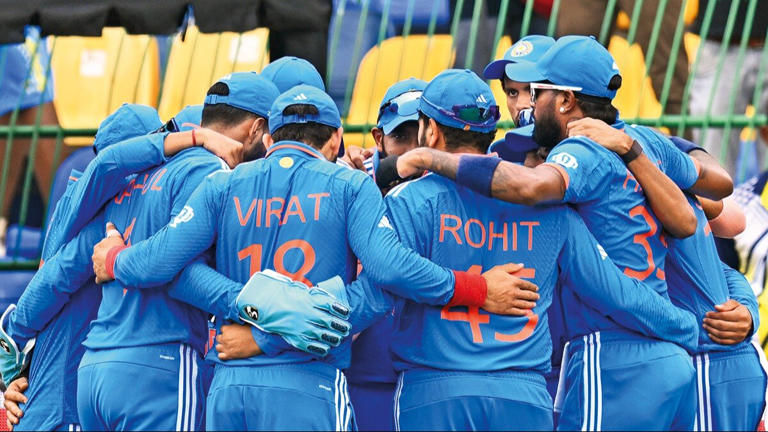Group India captain Rohit Sharma was just beginning to field questions from journalism after India’s thumping win in the Asia Cup last when he was disrupted by the deafening sound of crackers being ruptured exterior. He stopped briefly, enabled the sound to die down, and after that, nearly instinctively, said, “World Cup jeetne ke baad phodo, yaar (Burst the biscuits after we win the World Cup, people)!” While Rohit’s comment was in jest, it does encapsulate the state of mind of a cricket-mad country that has been experiencing an extensive title dry spell at the world level since 2011 when M.S. Dhoni led the Indian team to triumph.
There could be no much better time and area to finish that discomfort than the 2023 version of the ODI (one-day worldwide) World Mug. If there was a 28-year space between the moment Dhoni’s Daredevils lifted the cup and when Kapil’s Devils won it for the first time in 1983, the hope is that ‘Rohit’s Roarers will end the deadlock in this version. The ODI World Cup is taken into consideration as the G20 of cricket, the epitome of the white ball restricted overs variation of the game. Considering the inception of one-dayers in 1975, the World Cup has emerged as cricket’s masterpiece occasion, gaining around the world approval and also the greatest prize money in the sport– the 2023 edition has a total bag of $10 million or Rs 83.3 crore. The previous version saw a global cumulative online audience of 1.6 billion audiences: expect a dive by at least 40 percent this time as the circus moves across 10 venues, covering an overall 48 video games spread out across 46 days.
INDIA’S STAMINA
So can the Indian team pull it off? Fact be told, given the 2011 victory, they have been discovered desiring on the most significant stage, especially at critical junctures (see box Dry as Dust). Words were out– India can be beaten, and defeated in numerous methods. The Men in Blue arrived in Sri Lanka for the Asia Mug last month with inquiries aplenty: the openers had been misfiring; Virat Kohli had endured an extensive completely dry spot in ODIs; K.L. Rahul and also Shreyas Iyer’s suit health and fitness remained in question; all-rounder Hardik Pandya had not been in action as a bowler for long; bowlers Shardul Thakur and Axar Patel appeared to be in the group not on the dint of their efficiencies, but out of the large requirement to have allrounders to balance the having fun XI; and ace speedster Jasprit Bumrah was returning from a long-term injury without evidence to reveal that he had reclaimed the form or the strength to bowl the 10-over quota. Four weeks on, all questions have been laid to rest, the Indian XI has answered emphatically, controlling the continental championship and after that decimating a pure Australian side in a short, pre-Cup ODI series.
The warning signals had been sent out to the remainder of the cricketing world. In Shubman Gill– the highest run-scorer for India in ODIs this fiscal year– India has among the most talented young batters in world cricket. His impressive stroke play aside, the 24-year-old’s ability to equate excellent beginnings into significant knocks is sufficient proof that he has a head mature past his years. Captain Rohit Sharma, fresh from scaling Mount 10K in one-day cricket, seems to have lastly discovered the balance he’d been searching for in between strike as well as defense– a strategy that saw him do with the most effective strike price among the leading 6 run-getters in the Asia Mug.

If anyone ever questioned Virat, the Delhi superjock served as a prompt pointer of his ODI expertise by wrecking a match-winning century in a problem game versus Pakistan. That he’s now simply 2 centuries short of Sachin Tendulkar’s all-time ODI document of 49 heaps should suffice to sustain his fire ahead of the Mug. K.L. Rahul has climbed once again like the typical Phoenix metro. Down and out after a major back injury, the makeshift wicket-keeper orgasm middle-order bat has redeemed his place in the Indian beginning XI. His jaw-dropping batting average of 93 because of his return, coupled with the fact that he has been maintaining arches in all the suits– decorated with some magnificent catches as well as showing no signs of his injury– has assisted India in a lot more ways than one. Hardik Pandya the batter was never the fear. Hardik Pandya the T20 bowler had been a qualified property also. But the jury was still out on Hardik Pandya the ODI bowler. The Asia Cup, however, provided an emphatic decision: the sheer rate and control with which the vice-captain bowled was proper of a full-time ODI bowler as well as not the 6th bowling option he was usually considered as.
Without a doubt, India’s bowling device, also, has become the talk of the town. Bumrah is bowling as he’d never been far from worldwide cricket, disregarding top-order batters by using a mix of sheer pace and wise arrangements, equally as he had done before his 11-month-long injury lay-off. Chinaman Kuldeep Yadav, the man-of-the-tournament at the Asia Cup, has the entire cricket world scratching their heads, trying to find out his wrong ‘un. As well as the ever-before exuberant Mohammed Siraj, with his wobbled seam and also added bounce, has had unlucky opposition batters flailing around (his six-for in the Asia Cup last was a testament to that).
From not knowing what their optimal XI was nearly a month earlier, to ending up being the ‘idol XI’ of ODI cricket has marked rather a significant turn-around for this Indian group. It’s this variety of match-winners that has allowed India to win handsomely in current one-dayers, consisting of the three-match collection versus Australia that saw a rearguard fightback by the middle-order pair of K.L. Rahul and Surya Kumar Yadav to secure the initial ODI and a Gill-Iyer blitzkrieg that took India to a document total of 399 in the second. Quite clearly, this multi-pronged attack could be the X variable if India is to land the most significant reward in cricket.
CHINKS IN THE ARMOUR
However, work through the tough Indian exterior as well as analyze the finer details and some fractures start to show up in the arsenal. The lack of all-rounders, for one. Similar to today’s corporate workplace where multi-tasking is the buzzword, multi-dimensional gamers have ended up being a need in cricket; much more so in one-day cricket where the costs get on bowlers contributing with the bat and vice versa. This was also India’s secret sauce throughout the 2011 World Cup as the likes of Yuvraj Singh, Suresh Raina as well and Irfan Pathan– all proper batters– chipped in with essential advancements with the ball. However, that’s a deluxe this existing Indian team cannot afford, with any of their top-order batters bowling at the worldwide level regularly.
Blame it on the brand-new power-play rules– five fielders inside the 30-yard circle in between overs 11 to 40. Introduced in 2015 to rid the style of the ‘boring’ middle phase, it offers no respite to the bowlers. Combined with an additional rule modification of two new rounds from both ends– rather than using just one round for the whole 50 overs previously– and also the ODI layout looks to have changed substantially since 2011. A tough, relatively new round that comes onto the bat is much more conducive to stroke play than the worn-out, 40- or 50-overs old sphere that is sluggish off the pitch. The rules have caused teams to embrace the cavalier batting strategy of T20 cricket in ODIs, as is reflected in the ever-increasing group overalls in the 50-over style. Of the 24 events where a 400-plus score has been videotaped in ODI cricket, 15 have come since the 2011 World Cup.
Whatever the reasons for the inequality between the bat and sphere, the inflexibility brought on by the absence of authentic all-rounders leaves the Indian XI severely endangered. In an event where most top contenders bat as deep as No. 10, India can at best checklist batters till No. 8 by contacting all-rounders like Shardul, Axar, and Ashwin. After that, there’s the ‘fear-offailure’ fee that the team contends with perennially. Its genesis depends on India’s evident inability to bring its A-game on the big day, specifically seen in the knockout stages of world cups. Genuinely world-class teams are recognized to raise their performance a notch or more on D-days by playing fearlessly. India, on the other hand, has been figuring out playing percentage (read safe) cricket at the same stage. Is it the expectations of 1.44 billion Indians that weigh them down? “Indians play stats-driven cricket … they are too often, too worried about their stats. They are so terrified to take threats, due to what could be stated or printed,” is how former New Zealand cricketer Simon Doull parsed it throughout a recent program on Sky Sports. Will this ‘enfeeblement’ be magnified by the fact that India is the host, for it indicates pressure? As well as more stress.
THE RESIDENCE BENEFIT
Conversely, the ‘house benefit’ likewise presents India with its biggest possibility. The fact that the past three versions have seen the hosts pocket the one-day title tells an important story. Experience with the problems certainly provides house teams a gaining side. And on this count, no one fares far better than India, in India. In the period between the last World Mug in 2019 and till currently, India’s win-loss proportion in your home stands at a phenomenal 3.33 (winning 20 video games and also shedding simply 6). No team has an edge in neck-and-neck comparisons in ODIs played in India because of 2019. And whilst the argument that the Indian Premier League (IPL) has helped foreign players get accustomed to Indian problems does have merit, the stats are proof that India’s residence benefit is still an overwhelming proposition for most teams.
Former Indian staff member Harbhajan Singh describes in detail the technological benefit India gains when playing at residence. “Indian batters puncture gaps far better than other teams. That’s largely because they use the rate and also bounce on house premises better,” says the 2011 World Mug champion. “While other teams like Australia as well as England have to take dangers when trying to find limits in India, our batters, acquainted with the ground conditions, can increase the scoring price without taking any. The effect is that we have much more boundary-hitters in our team contrasted to any other.” The Indian caravan will cross nine places during the group stages (see The Long Road to Triumph). As well as every game, India will certainly begin as favorites owing to their present ODI world No. 1 ranking as well as the great form they have revealed the past month.
The locations will certainly help as well. England as well as Australian line-ups, bred on quickly, seaming problems, will certainly encounter India on the spin-friendly pitches of Lucknow and Chennai, specifically. Pakistan, with its pace-bowling strength and a little unskilled batting, will certainly choose a low-scoring game to provide themselves with the best chance to defeat India. However, anticipate Ahmedabad, the location of the India-Pakistan clash, to use a track with lots of runs in it, favoring India’s stamina in batting while doing so. Only New Zealand as well as South Africa, in Dharamshala as well as Eden Gardens, specifically, could nullify India’s residence benefit to a certain degree as both challengers will certainly relish the seam-friendly problems on offer at these locations. Though, even below, with the Indian pace-bowling attack of Bumrah, Shami, Siraj, and Pandya firing on all cylindrical tubes, the Indians would have their noses in front.
But India wouldn’t want to rely upon residence problems alone. In trainer Rahul Dravid, a male who constantly trusted his methods as well as procedure as a player, they have someone who will certainly have prepared a 360-degree roadmap, with data-driven techniques and matches creating an indispensable part of the project. There is a lot at risk for Dravid too. The Board of Control for Cricket in India (BCCI) generated the seventh-highest run-scorer in the background of global cricket with only one goal in mind: landing a prize at the world level. Dravid’s two years at the helm have been altered by exits in the semis of the 2022 T20 World Cup and also the loss in the final of the 2023 World Test Champion (WTC). This, then, might well be the Wall surface’s last hurrah. “I think it is really clear that for the Indian public, absolutely nothing except a World Mug win will certainly do. For Dravid as well as even Rohit Sharma, their tradition as trainer and captain will be decided based on where India coatings this World Mug,” batting legend and also 1983 World Cup victor Sunil Gavaskar told India Today.
THREATS IN ADVANCE
How frequently have we listened to lines like: ‘Never cross out New Zealand in an ICC event’, ‘Pakistan is always dangerous’, and also ‘Underestimate South Africa at your very own hazard’. Yet, past these challenges, both largest the consumers for India will certainly be available in the form of Australia and England. England’s technique in red ball cricket has brought them much attention. Labeled ‘Baseball’– called after their Test train Brendon McCullum– it’s ODI-style batting where batsmen keep a healthy strike rate by going after the bowlers and also compelling captains to spread out the area (envision several Virender Sehwags in a single batting schedule if you will). Yet, it’s just how England has played white-ball cricket that’s changing the sporting activity. The outcomes bear testimony to this: England are the ODI as well as T20 world champs, yet are to play a WTC final and also last won the Powders in 2015.
What’s benefited the Three Lions has been their fearless technique– despite the suit scenario, irrespective of the arches down, the English batters never appear to curb their assaulting instincts. It’s the same for Australia. Naturally, it’s their abundant tank of complex players that permits these two teams to bat as deep as they do. Consequently, it manages them the high-end of going hammer and tongs throughout their batting innings. Compare that to a team like India, which is scuttling for a spin bowling allrounder simply days ahead of the Cup. Injury to Axar Patel has caused the team to return to a 37-year-old Ashwin, who before his recall for the house collection versus Australia hadn’t played an ODI match for 20 months. The distinction couldn’t be starker. For India to duplicate the heroics of 1983 and 2011, a lot will certainly rely on aspects beyond cricketing logic. Late night dew in October-November makes winning the throw critical. Include in that the luck aspect– the odd runout, a gone down catch, untimely rain interruptions. Without the rub of the eco-friendly going their method, no group is guaranteed success. It’s these glorious uncertainties that make the Cricket World Cup one of the greatest sports spectacles on Earth.










Average Rating